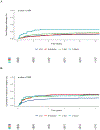Relationship Between Pretransplantation Nutritional Status and Outcome in Adults with Acute Myelogenous Leukemia Undergoing Allogeneic Hematopoietic Cell Transplantation
- PMID: 36179985
- PMCID: PMC9729404
- DOI: 10.1016/j.jtct.2022.09.023
Relationship Between Pretransplantation Nutritional Status and Outcome in Adults with Acute Myelogenous Leukemia Undergoing Allogeneic Hematopoietic Cell Transplantation
Abstract
Pretransplantation nutritional status may impact outcome after allogeneic hematopoietic cell transplantation (HCT). Various simple screening tools have been developed and used to identify patients at risk of malnutrition; however, how best to use these screening tools is unclear, and their accuracy for the prediction of adverse outcomes is unknown. To investigate how these different measures contribute to outcome prediction, we examined a large cohort of adults with acute myelogenous leukemia (AML) who underwent allogeneic HCT in first or second remission at our institution between April 2006 and May 2021. We assessed the prognostic role of the Nutrition Risk Index (NRI), which combines weight loss and serum albumin, in 970 adults with AML in first or second remission who had usual body weight information available at AML diagnosis or relapse and before HCT. A low NRI at the time of conditioning for HCT was associated with higher nonrelapse mortality (hazard ratio [HR], .97; 95% confidence interval [CI], .95 to .98; P < .001) and relapse risk (HR, .98; 95% CI, .96 to .99; P < .001) and decreased relapse-free survival (HR, .97; 95% CI, .96 to .98; P < .001) and overall survival (HR, .97; 95% CI, .96 to .98; P < .001), as was a low pre-HCT serum albumin level. After multivariable adjustment, NRI, but not weight loss alone, was associated with outcome. The predictive ability of NRI was overall relatively low and comparable to that of serum albumin, with a C-statistic not exceeding .59. Taken together, our data indicate that pre-HCT level of serum albumin, an acute-phase protein recognized to more accurately reflect the severity of the inflammatory response compared with poor nutritional status, but not weight loss, is independently associated with post-HCT outcome in patients with AML. © 2022 American Society for Transplantation and Cellular Therapy. Published by Elsevier Inc.
Keywords: Acute myelogenous leukemia; Allogeneic hematopoietic cell transplantation; Malnutrition; Nutritional Risk Index; Nutritional status; Weight loss.
Copyright © 2022 The American Society for Transplantation and Cellular Therapy. Published by Elsevier Inc. All rights reserved.
Figures


Similar articles
-
Cytomegalovirus Reactivation after Allogeneic Hematopoietic Stem Cell Transplantation is Associated with a Reduced Risk of Relapse in Patients with Acute Myeloid Leukemia Who Survived to Day 100 after Transplantation: The Japan Society for Hematopoietic Cell Transplantation Transplantation-related Complication Working Group.Biol Blood Marrow Transplant. 2015 Nov;21(11):2008-16. doi: 10.1016/j.bbmt.2015.07.019. Epub 2015 Jul 26. Biol Blood Marrow Transplant. 2015. PMID: 26211985
-
Cytogenetic risk determines outcomes after allogeneic transplantation in older patients with acute myeloid leukemia in their second complete remission: A Center for International Blood and Marrow Transplant Research cohort analysis.Cancer. 2017 Jun 1;123(11):2035-2042. doi: 10.1002/cncr.30567. Epub 2017 Jan 24. Cancer. 2017. PMID: 28117898 Free PMC article.
-
Single Cord Blood Transplantation Versus Unmanipulated Haploidentical Transplantation for Adults with Acute Myeloid Leukemia in Complete Remission.Transplant Cell Ther. 2021 Apr;27(4):334.e1-334.e11. doi: 10.1016/j.jtct.2021.01.023. Epub 2021 Jan 28. Transplant Cell Ther. 2021. PMID: 33836881
-
Efficacy of a Second Allogeneic Hematopoietic Cell Transplant in Relapsed Acute Myeloid Leukemia: Results of a Systematic Review and Meta-Analysis.Transplant Cell Ther. 2022 Nov;28(11):767.e1-767.e11. doi: 10.1016/j.jtct.2022.08.008. Epub 2022 Aug 13. Transplant Cell Ther. 2022. PMID: 35970301
-
Hematopoietic Cell Transplantation in the Treatment of Pediatric Acute Myelogenous Leukemia and Myelodysplastic Syndromes: Guidelines from the American Society of Transplantation and Cellular Therapy.Transplant Cell Ther. 2022 Sep;28(9):530-545. doi: 10.1016/j.jtct.2022.06.005. Epub 2022 Jun 16. Transplant Cell Ther. 2022. PMID: 35717004 Review.
Cited by
-
Measurable residual disease as predictor of post-day +100 relapses after allografting in adult AML.Blood Adv. 2025 Feb 11;9(3):558-570. doi: 10.1182/bloodadvances.2024013214. Blood Adv. 2025. PMID: 39374582 Free PMC article.
-
Geriatric nutritional risk index as a predictor of prognosis in hematologic malignancies: a systematic review and meta-analysis.Front Nutr. 2023 Oct 24;10:1274592. doi: 10.3389/fnut.2023.1274592. eCollection 2023. Front Nutr. 2023. PMID: 37941772 Free PMC article.
-
Association between Prior Cytotoxic Therapy, Antecedent Hematologic Disorder, and Outcome after Allogeneic Hematopoietic Cell Transplantation in Adult Acute Myeloid Leukemia.Cancers (Basel). 2023 Jan 5;15(2):352. doi: 10.3390/cancers15020352. Cancers (Basel). 2023. PMID: 36672303 Free PMC article.
-
Which Nutritional Scoring System Best Predicts Transplant Outcomes in Allogeneic Stem Cell Recipients? A Comparison of Nutritional Risk Index, Prognostic Nutritional Index, and Controlling Nutritional Status.Sisli Etfal Hastan Tip Bul. 2025 Mar 18;59(1):64-75. doi: 10.14744/SEMB.2025.74050. eCollection 2025. Sisli Etfal Hastan Tip Bul. 2025. PMID: 40226570 Free PMC article.
-
Comparison of reduced intensity and nonmyeloablative conditioning for adults with acute myeloid leukemia undergoing allogeneic hematopoietic cell transplantation in first or second remission.Bone Marrow Transplant. 2023 Apr;58(4):377-385. doi: 10.1038/s41409-022-01909-x. Epub 2022 Dec 28. Bone Marrow Transplant. 2023. PMID: 36577856 Free PMC article.
References
-
- Dewys WD, Begg C, Lavin PT, Band PR, Bennett JM, Bertino JR et al. Prognostic effect of weight loss prior tochemotherapy in cancer patients. Am J Med 1980; 69: 491–497. - PubMed
-
- Fearon K, Strasser F, Anker SD, Bosaeus I, Bruera E, Fainsinger RL et al. Definition and classification of cancer cachexia: an international consensus. Lancet Oncol 2011; 12: 489–495. - PubMed
-
- Aapro M, Arends J, Bozzetti F, Fearon K, Grunberg SM, Herrstedt J et al. Early recognition of malnutrition and cachexia in the cancer patient: a position paper of a European School of Oncology Task Force. Ann Oncol 2014; 25: 1492–1499. - PubMed
-
- Arends J, Baracos V, Bertz H, Bozzetti F, Calder PC, Deutz NEP et al. ESPEN expert group recommendations for action against cancer-related malnutrition. Clin Nutr 2017; 36: 1187–1196. - PubMed
Publication types
MeSH terms
Substances
Grants and funding
LinkOut - more resources
Full Text Sources
Medical
Miscellaneous

